.
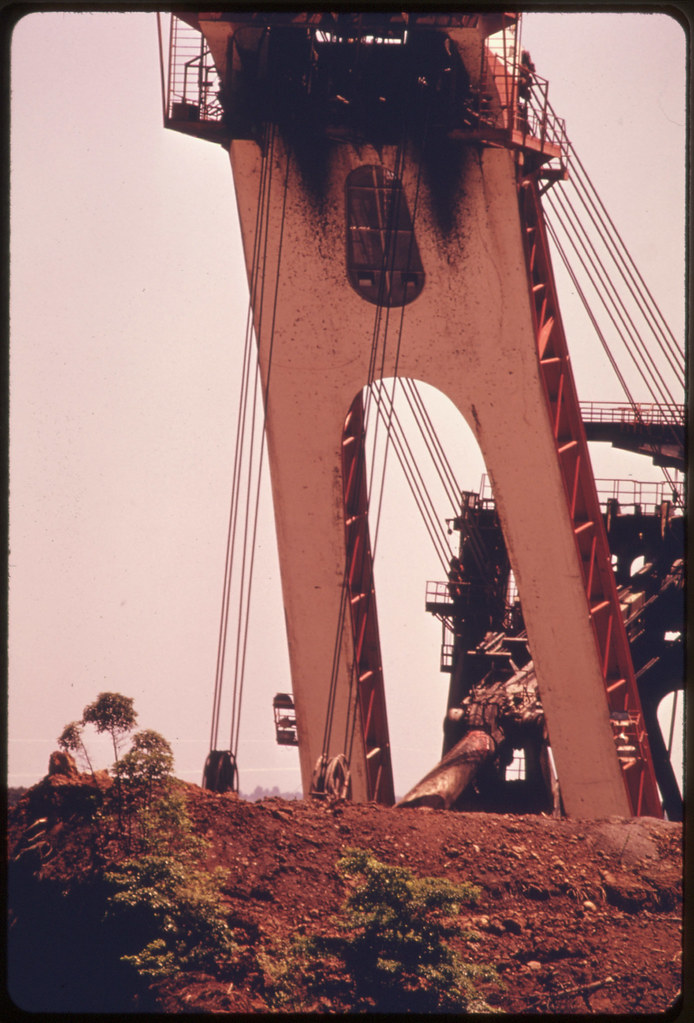
Head of the giant "Silver Spade" coal shovel owned by the Hanna Coal Company dwarfs some trees as the machine scoops coal from a trench. Cadiz, Ohio: photo by Erik Calonius for the Environmental Protection Agency's Documerica Project, July 1974
The suffering, now
unceasing. The sense of violation
unceasing. The sense of violation
passive and in the face
of extraction, unresisting
as can be seen in this general view.
as can be seen in this general view.
They came and cut out the parts
they wanted, and took them away.
What remained was changed
forever, as a waste of shame
lost in its own autism,
last refuge of the victim without
a name.
a name.
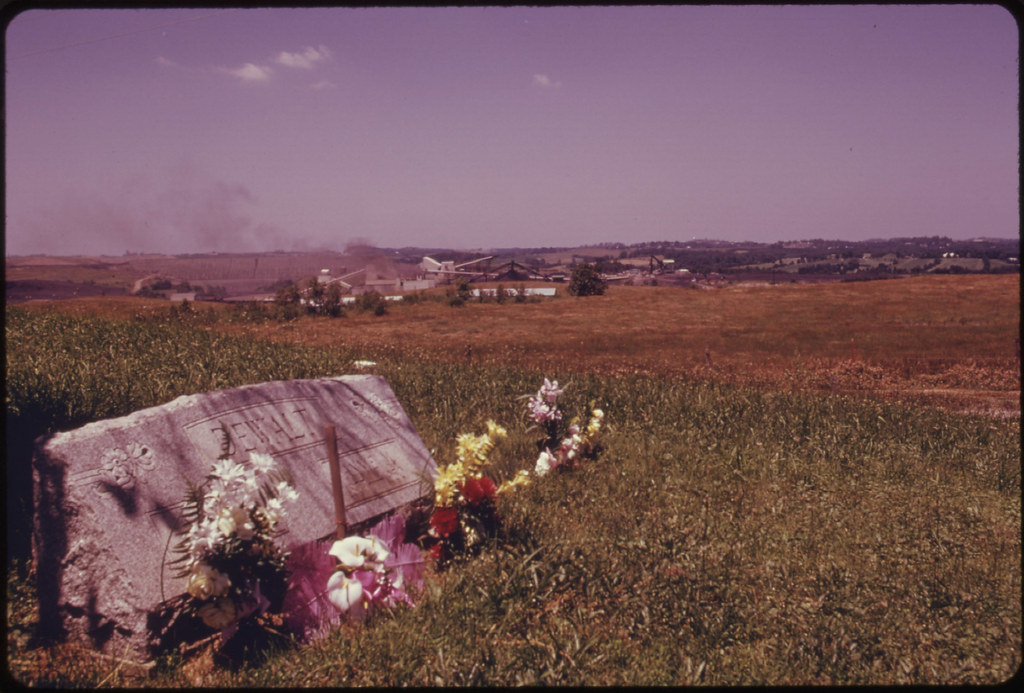
Tombstone marking a grave in a cemetery at Cadiz, Ohio. The Hanna Coal Company preparation plant is seen in background: photo by Erik Calonius for the Environmental Protection Agency's Documerica Project, July 1974 (US National Archives)
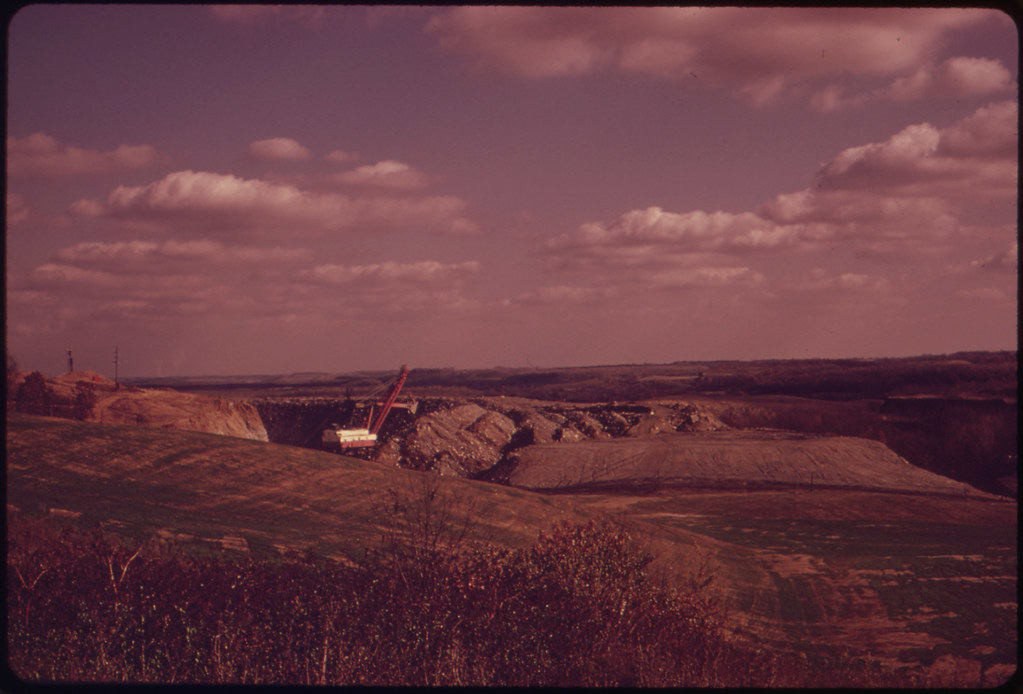
A coal shovel works into a hillside of Route 9, near Cadiz, Ohio and Steubenville: photo by Erik Calonius for the Environmental Protection Agency's Documerica Project, October 1973
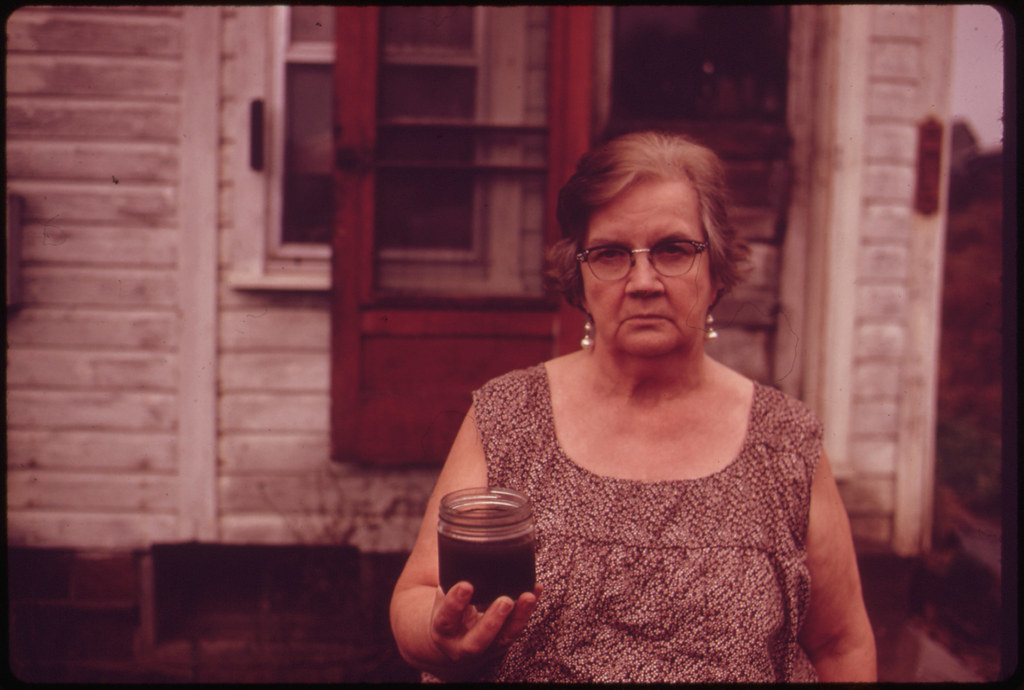
Mary Workman of Steubenvile, Ohio holds a jar of undrinkable water that comes from her well. She has filed a damage suit against the Hanna Coal Company. She has to transport water from a well many miles away. Although the coal company owns all the land around her, and many roads are closed, she refuses to sell: photo by Erik Calonius for the Environmental Protection Agency's Documerica Project, October 1973

Abandoned coal tipple surrounded by miles of stripped land. Stagnant water lies in the ditches in apparent violation of Ohio law. Off Route 519. New Athens, Ohio: photo by Erik Calonius for the Environmental Protection Agency's Documerica Project, October 1973
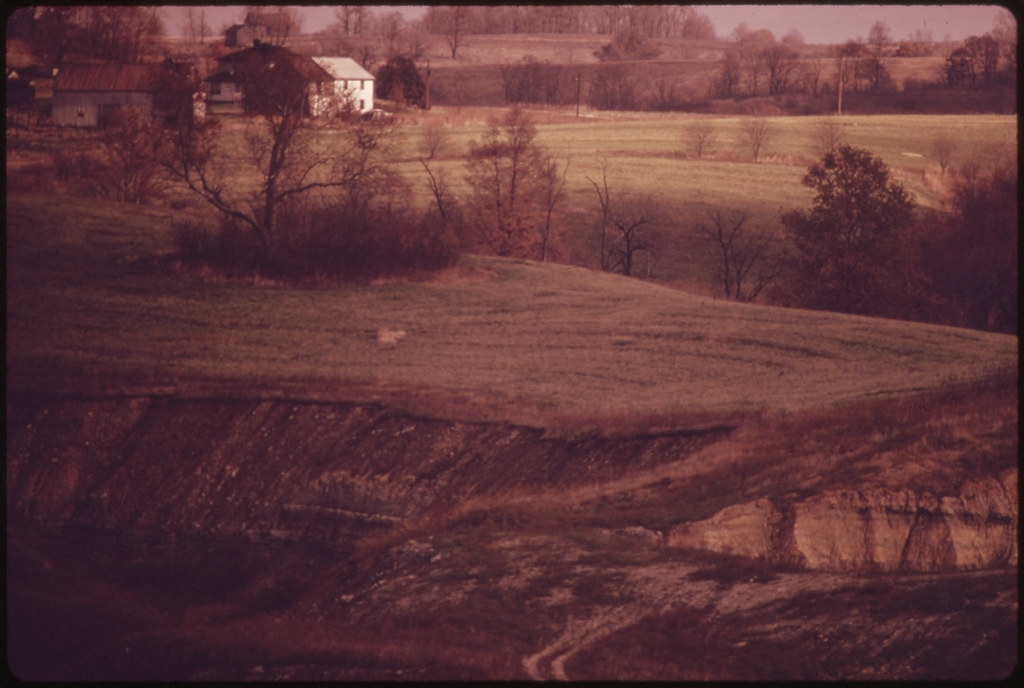
This land was stripped 20 years ago (note scar in foreground). The land around it Is still farmed. Off Route 22. New Athens, Ohio: photo by Erik Calonius for the Environmental Protection Agency's Documerica Project, October 1973
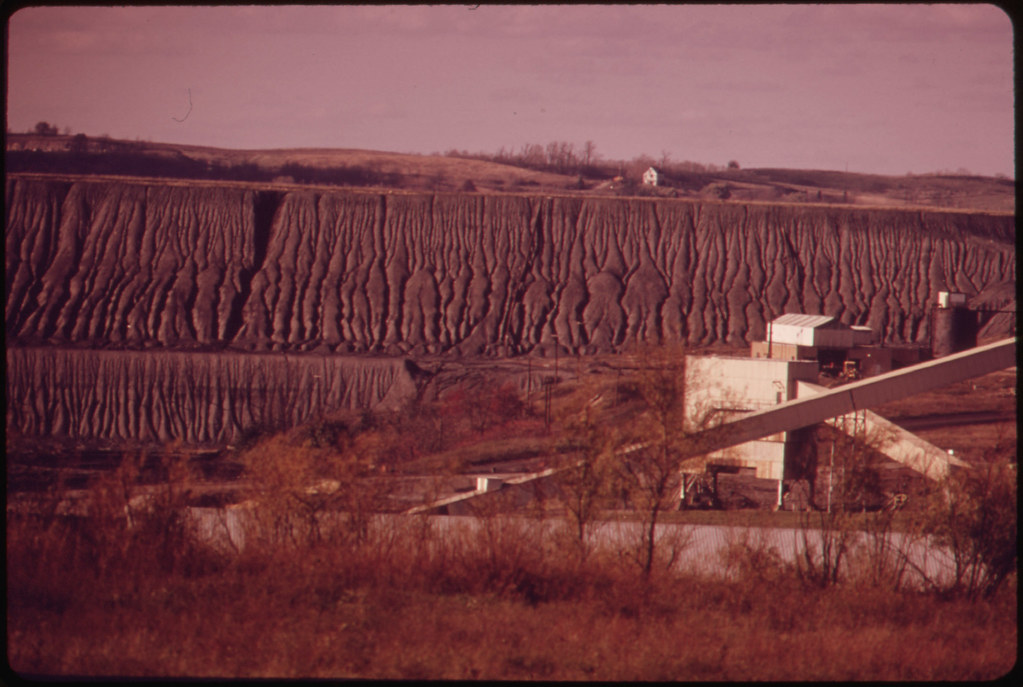
The land of Belmont and Harrison counties in southeastern Ohio has been scarred by more than twenty years of strip mining. Here a huge bank of coal slag has been left to erode and possibly pollute local water supplies. New Athens, Ohio: photo by Erik Calonius for the Environmental Protection Agency's Documerica Project, October 1973

Previously strip mined land erodes if not recontoured by the coal companies. Near New Athens, Ohio: photo by Erik Calonius for the Environmental Protection Agency's Documerica Project, July 1974
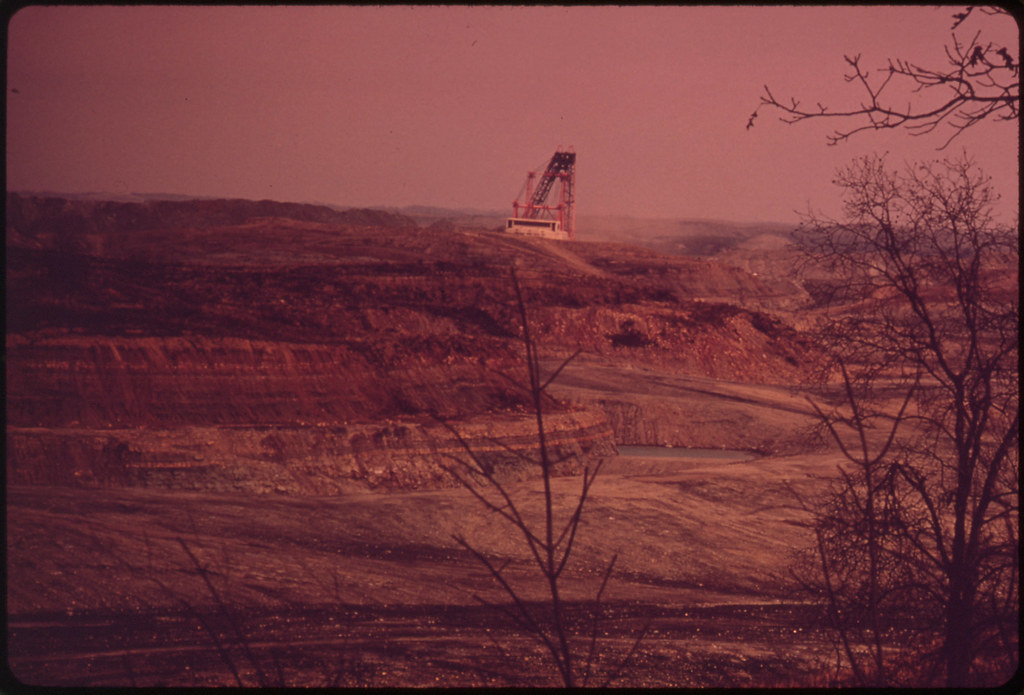
The "Silver Spade" coal shovel owned by the Hanna Coal Company dominates the barren landscape, off Route 9. Hanoverton, Ohio: photo by Erik Calonius for the Environmental Protection Agency's Documerica Project, October 1973
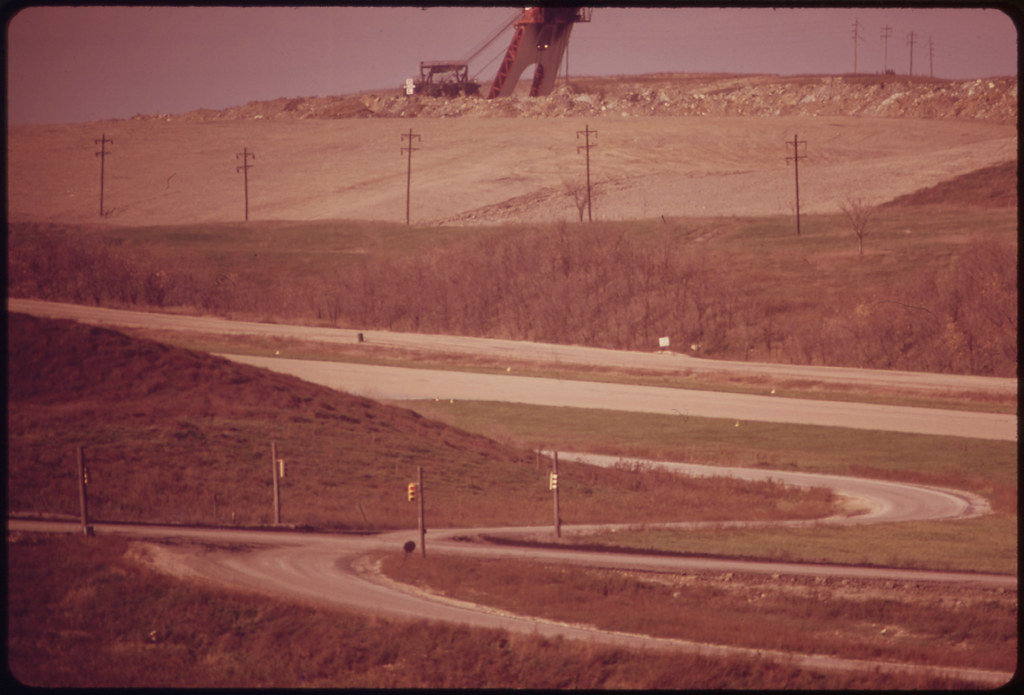
The "Silver Spade," one of the larger shovels owned by the Hanna Coal Company, dominates the horizon at Route 9, near Cadiz Ohio, and Steubenville: photo by Erik Calonius for the Environmental Protection Agency's Documerica Project, October 1973
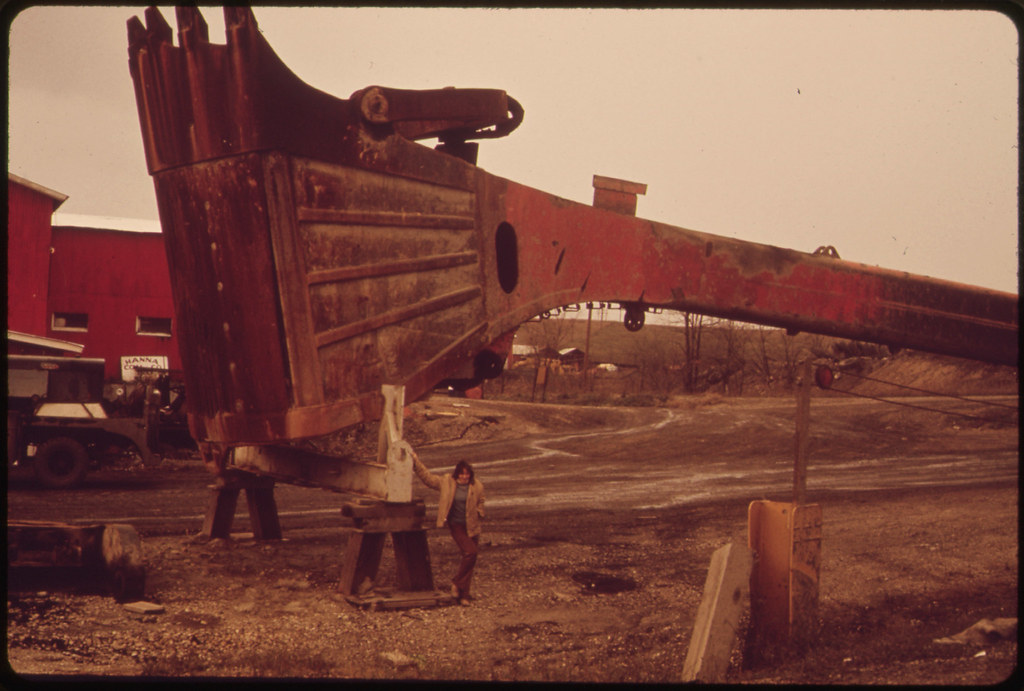
One of the small coal shovels, off Route 9, near Cadiz, Ohio, and Steubenville: photo by Erik Calonius for the Environmental Protection Agency's Documerica Project, October 1973
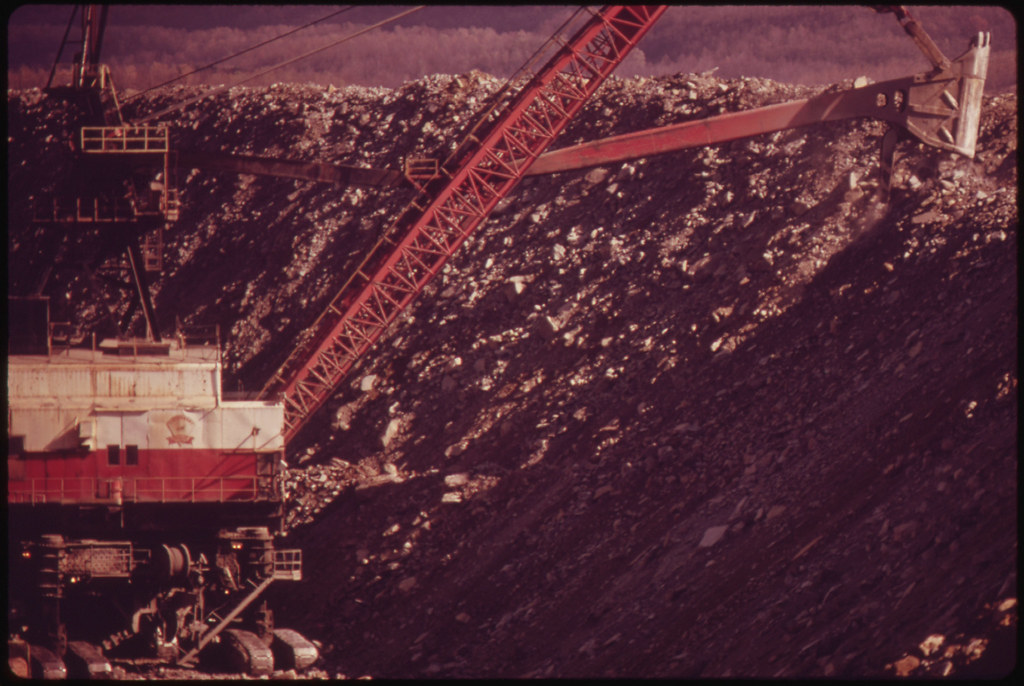
The land of Belmont and Harrison counties in southeastern Ohio has
been scarred by more than twenty years of strip mining. Here a huge bank
of coal slag has been left to erode and possibly pollute local water
supplies: photo by Erik Calonius for the Environmental Protection Agency's Documerica Project, October 1973
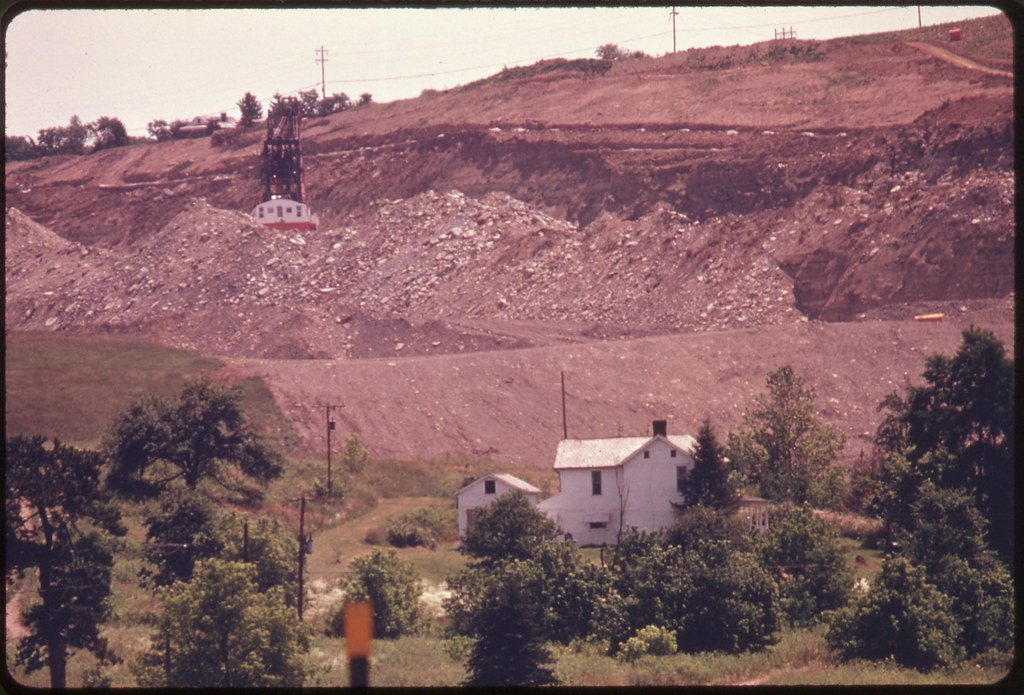
Coal shovel and strip mining form the backdrop of this house at the intersection of Interstate 70 and Route #800 near Morristown, Ohio: photo by Erik Calonius for the Environmental Protection Agency's Documerica Project, July 1974
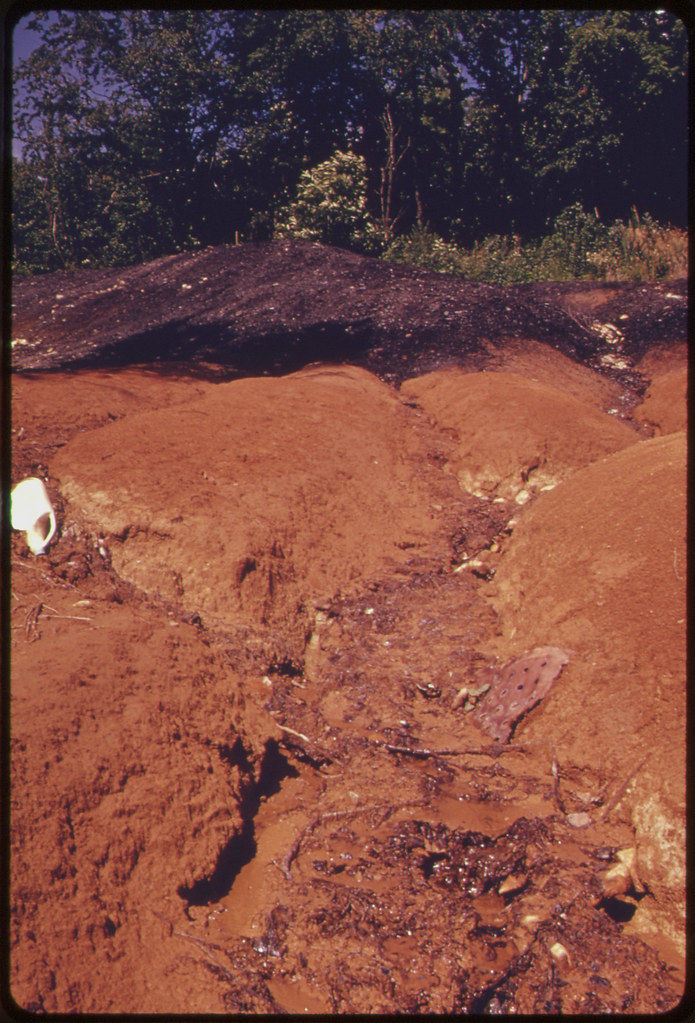
Soil leached and discolored by dumped coal slag near Cadiz, Ohio: photo by Erik Calonius for the Environmental Protection Agency's Documerica Project, July 1974
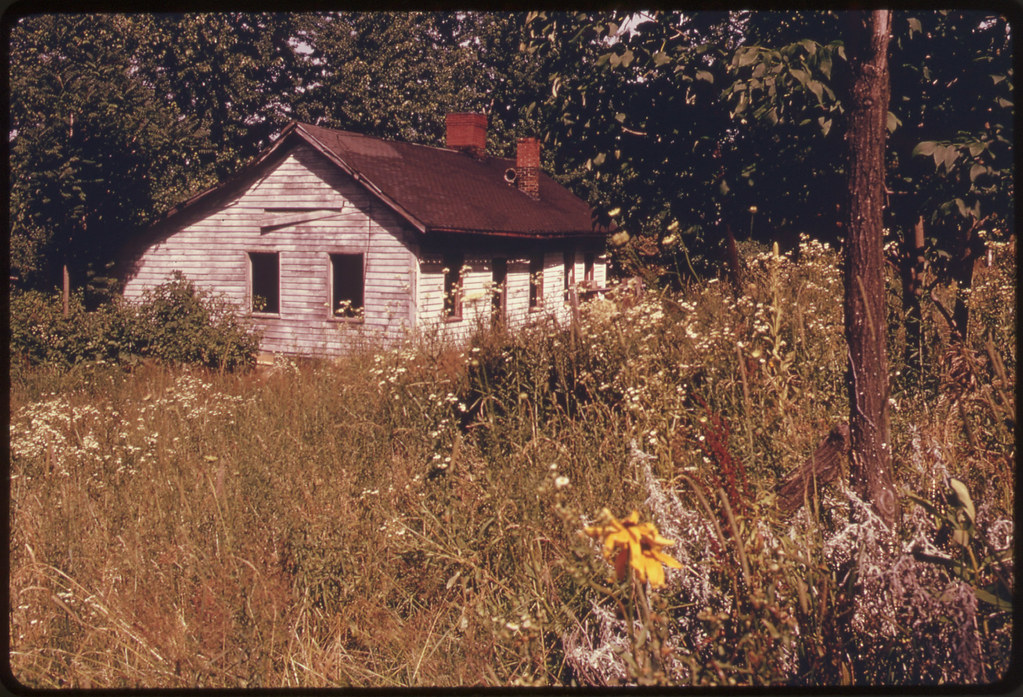
Abandoned house near land strip mined by coal companies near the intersection of Interstate 70 and Route #800, near Morristown, Ohio: photo by Erik Calonius for the Environmental Protection Agency's Documerica Project, July 1974

Abandoned house near land strip mined by coal companies near the intersection of Interstate 70 and Route #800, near Morristown, Ohio: photo by Erik Calonius for the Environmental Protection Agency's Documerica Project, July 1974

This house stands above a stripped gorge off Route 250, near Cadiz, Ohio, and Steubenville: photo by Erik Calonius for the Environmental Protection Agency's Documerica Project, October 1973
.
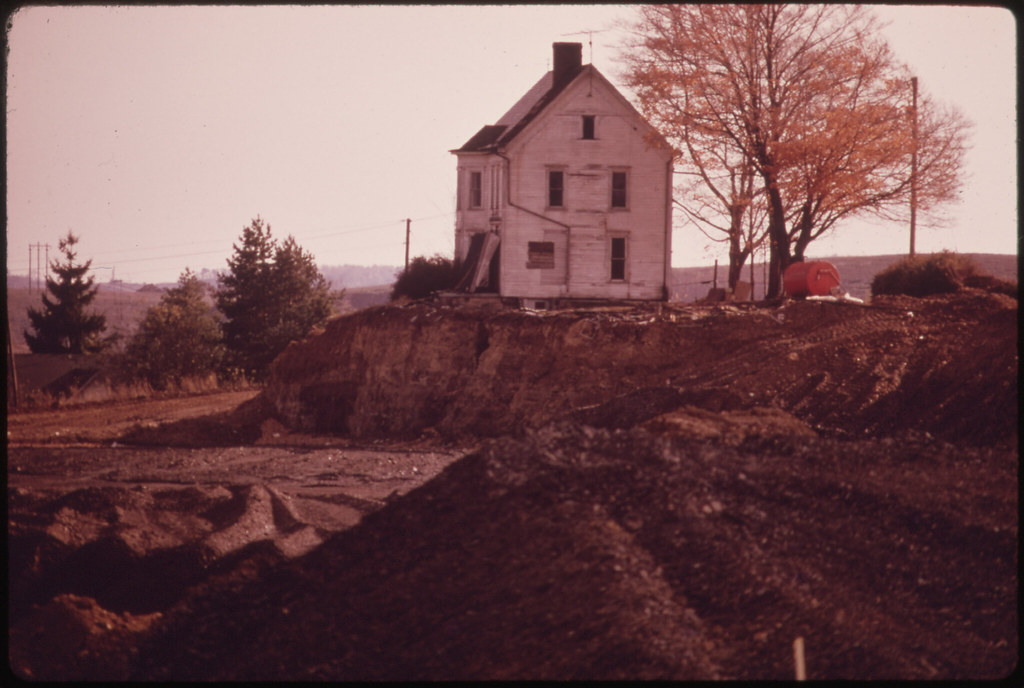
This house off Route 250, near Cadiz, Ohio, has had its windows and doors knocked out, legally qualifying it as "derelict." Now the coal company is stripping around it: photo by Erik Calonius for the Environmental Protection Agency's Documerica Project, October 1973
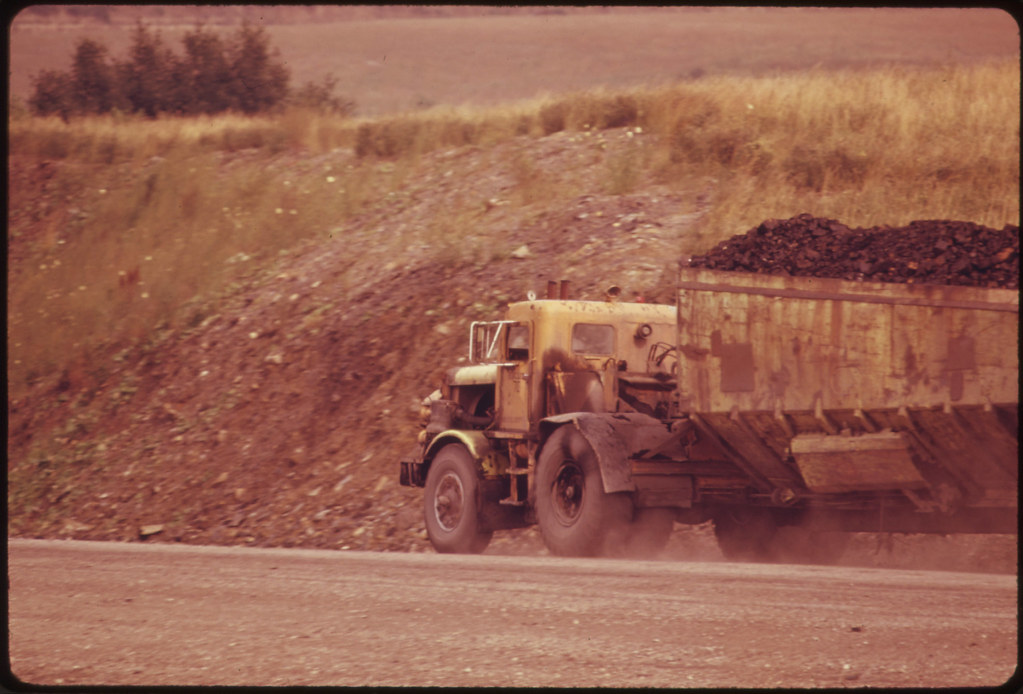
Coal hauling truck on Route #519. Near New Athens, Ohio: photo by Erik Calonius for the Environmental Protection Agency's Documerica Project, July 1974
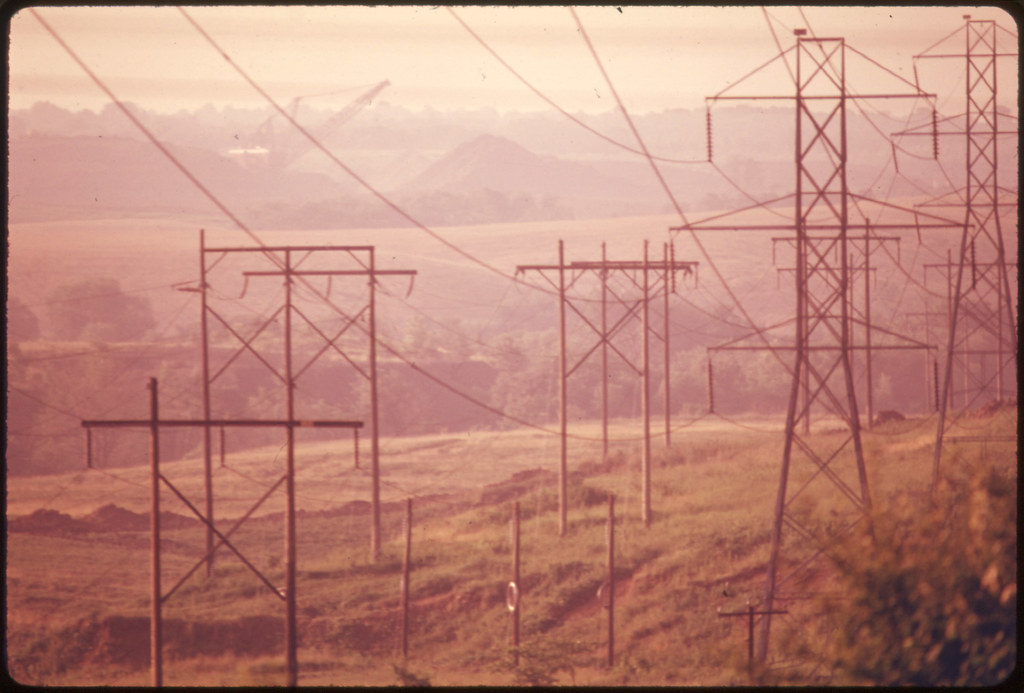
Hazy atmosphere of early morning with strip mining being carried on by coal companies behind the power lines. Near New Athens, Ohio: photo by Erik Calonius for the Environmental Protection Agency's Documerica Project, July 1974

Strip mining coal shovel abandoned in a field where it once had been used. Athens, Ohio: photo by Erik Calonius for the Environmental Protection Agency's Documerica Project, July 1974
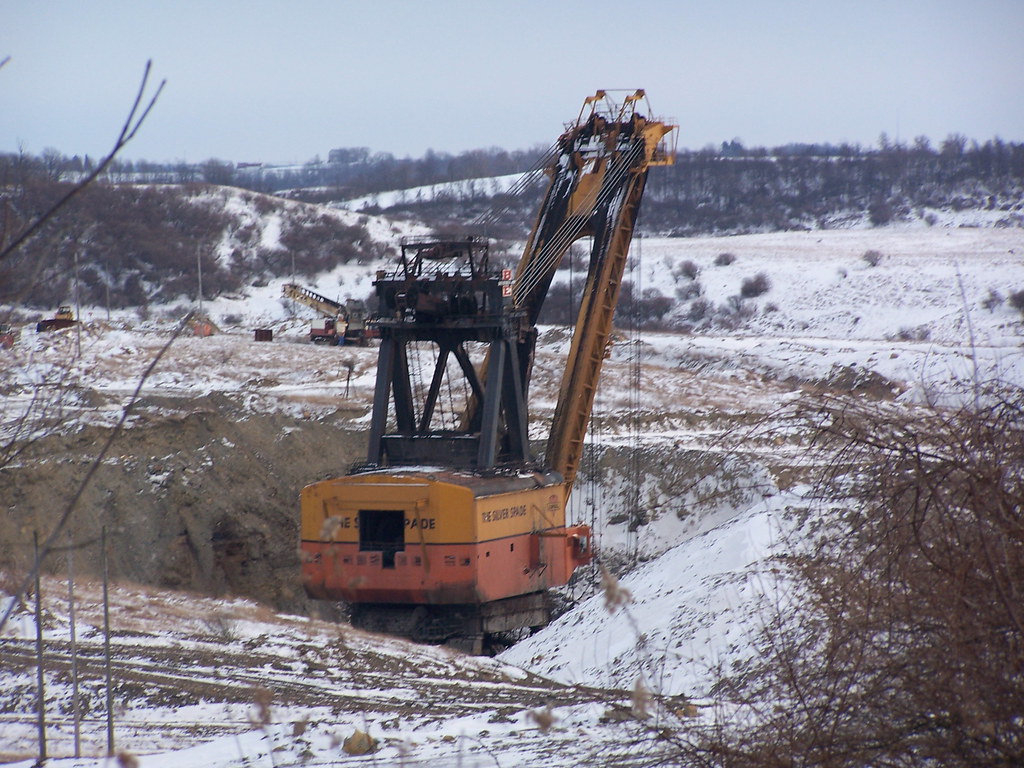

Abandoned "Silver Spade" coal dragline outfit, New Athens, Ohio: photo by Brian Powell (bitmapped), 4 February 2007

A mural in the former boomtown of Glouster, Athens County, Ohio: photo by Matt Eich, 29 May 2008

A mural in the former boomtown of Glouster, Athens County, Ohio: photo by Matt Eich, 29 May 2008

A family crosses the tracks after work in the former coal boomtown of Glouster, Athens County, Ohio: photo by Matt Eich, 17 May 2008

Lisa Russel, 20, and other teens hang out on the street corners in
Glouster, Ohio on Saturday. Glouster was once a thriving
community in southeastern Ohio, but with the departure of extractive
industries such as coal mining the town's economic sources dried up. The
town youth have little to do and substance abuse runs rampant: photo by Matt Eich, 24 May 2008

Escalating horseplay, Glouster, Ohio, Saturday: photo by Matt Eich, 17 May 2008

A teenager smokes a joint while rolling down a country road in Glouster, Ohio on Saturday: photo by Matt Eich, 17 May 2008

Nicole Goins stands holding her daughter Jayden, 2, in Chauncey, Ohio on
Thursday, as her friend Cheryl grabs her son Little Man,
2, who had run across Route 13 and headed towards the train tracks
before his mother noticed he was gone: photo by Matt Eich, 15 April 2010

American Legion members prepare to sing the Pledge of Allegiance in Guysville, Ohio: photo by Matt Eich, 23 June 2012



Jean Bullock (R) and her mother Madeline in Chauncey, Ohio: photo by Matt Eich, 24 June 2012

Trucks move loads of coal at Sands Hill strip mine in Vinton, Ohio on Wednesday: photo by Matt Eich, 15 May 2008


A patron sits in Ali's bar in Glouster, Ohio. Glouster was once a
thriving community in Southeastern Ohio, but with the departure of
extractive industries such as coal mining the town's economic sources
dried up. The town residents have little to do and substance abuse runs
rampant: photo by Matt Eich

The wind blows in an empty field in Glouster, Ohio on Saturday: photo by Matt Eich, 17 May 2008

The wind blows in an empty field in Glouster, Ohio on Saturday: photo by Matt Eich, 17 May 2008
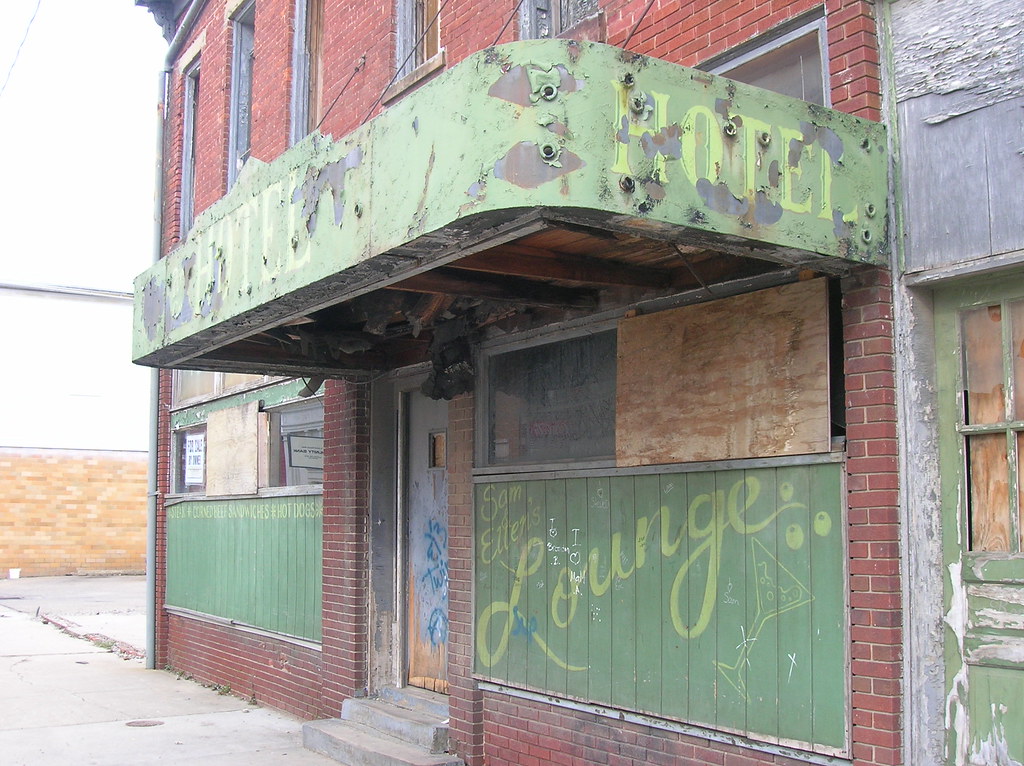
Hotel, Glouster, Ohio: photo by oldohioschools, 29 March 2008
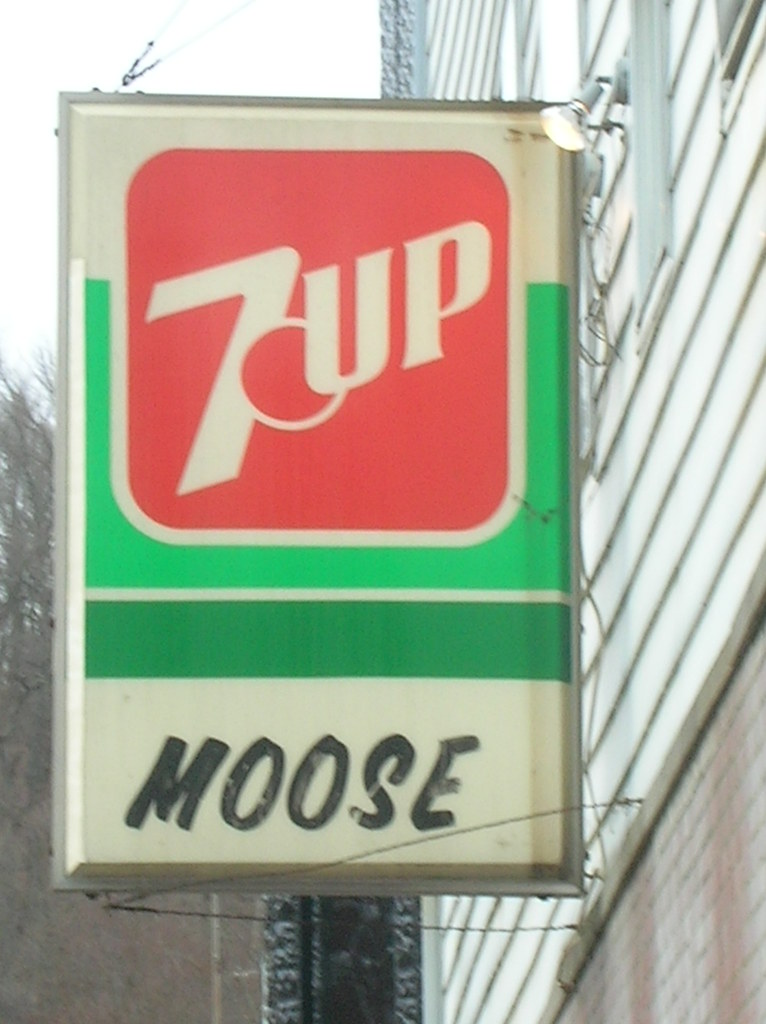
Moose, Glouster, Ohio: photo by oldohioschools, 29 March 2008

Two stray dogs stalk the streets of Glouster, Ohio: photo by Matt Eich, 17 May 2008

Clayton Ator riles up Shank and Money after getting stoned. Ator, an ex-con learned to "shoot ink" in prison and does prison style tattoos out of his living room in Carbondale, Ohio: photo by Matt Eich, 5 February 2007

A Grevy's zebra named "Elvis" stomps in the snow of his outdoor pen at The Wilds in Cumberland, Ohio. Situated on 10,000 acres of reclaimed strip mine land, The Wilds is a research and conservation facility for rare and endangered animals. During the warmer months animals are allowed to roam freely but in the winter are kept in heated indoor pens: photo by Matt Eich, 27 February 2008

Viewed through a collection of medicine bottles lining the Sellers' window, Hercules crouches to watch the children playing in the snow. The Sellers family struggles with an assortment of health problems. Most of their children have asthma and twins Kacey and Lacey, 5, were both born profoundly deaf. Chauncey, Ohio: photo by Matt Eich

Kacey Sellers, 8, bathes the ferrets she and her identical twin sister
Lacey keep as pets. The girls were both born deaf and only recently
began attending a deaf school when their parents moved to the larger
urban area of Columbus, Ohio: photo by Matt Eich


Tylor Woodrum, 16, holds a box containing his father's ashes on January
30, 2007 in Carbondale, Ohio. Dave Woodrum was killed in August of 2006
in a high-impact 4-wheeler accident. Dave's family had his body cremated
and his favorite cock-fighting rooster mounted on top of the box: photo by Matt Eich, 30 January 2007

Richie Goins shows off his pet snake while his girlfriend Tracie folds clothes next to Richie's brother, Timmy, who has cerebral palsy and requires around the clock care. Chauncey, Ohio: photo by Matt Eich

Richie Goins shows off his pet snake while his girlfriend Tracie folds clothes next to Richie's brother, Timmy, who has cerebral palsy and requires around the clock care. Chauncey, Ohio: photo by Matt Eich

Troy Goins, 16, sucks his toe to console himself as he sits on his new bed in his mother’s trailer. His autism makes it difficult for him to deal with even the smallest changes and self-stimulation is his way of coping. Chauncey, Ohio: photo by Matt Eich
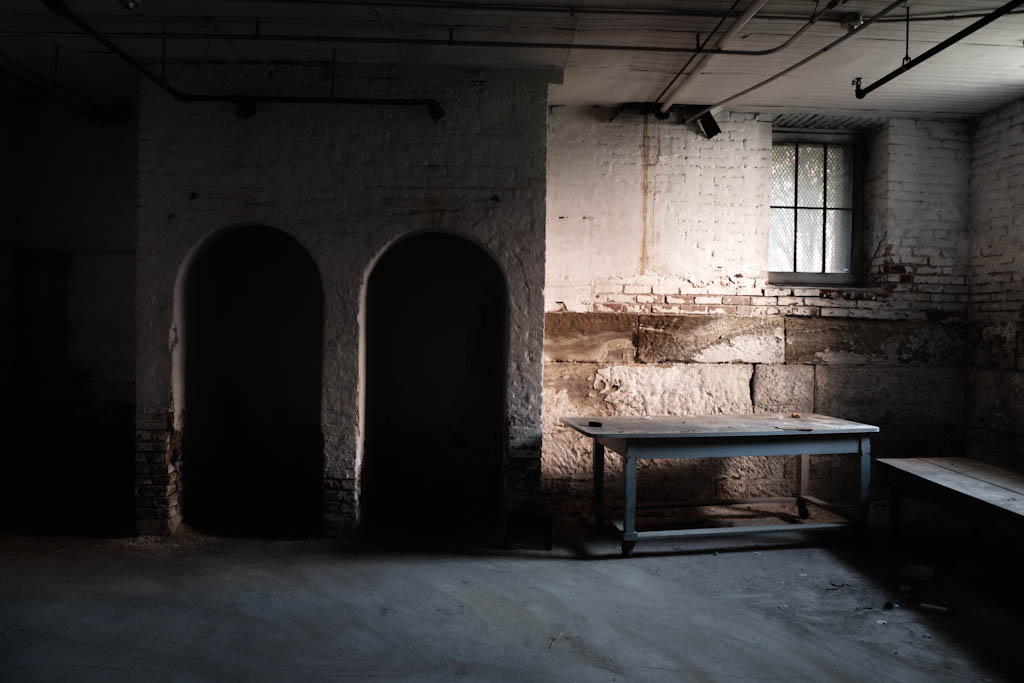
The Ridges: Lin Hall Underground. In the tunnels under the main building of "The Ridges", aka Athens Lunatic Asylum, Athens, Ohio: photo by stimply, 12 May 2009
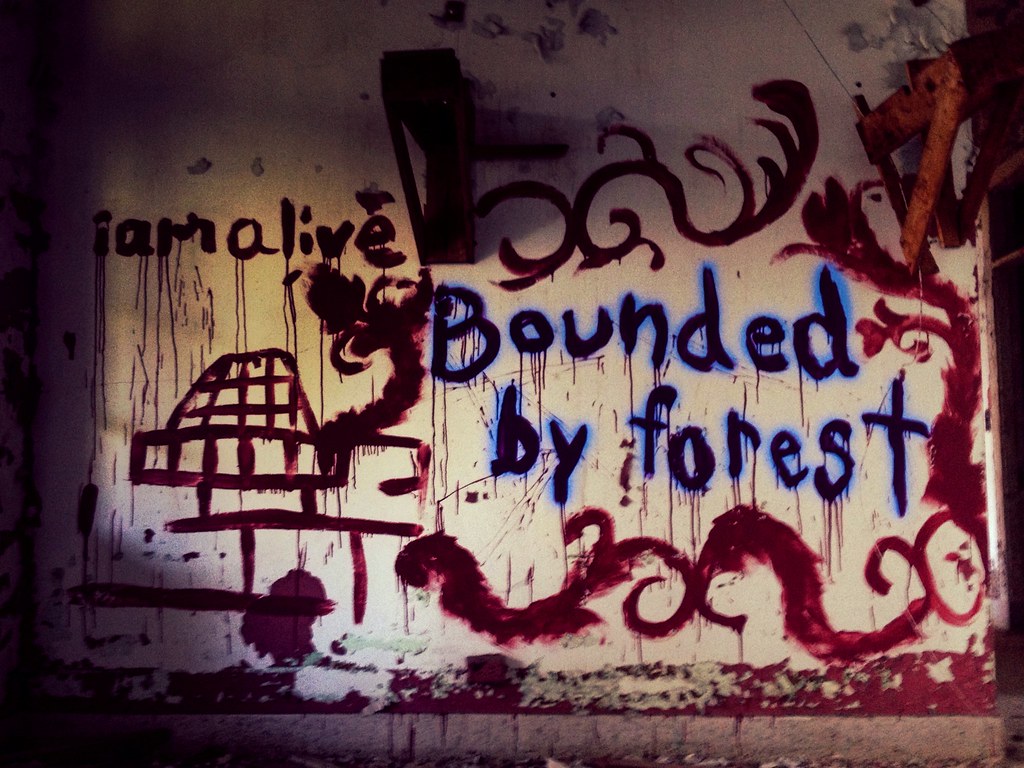

The Ridges: Lin Hall Underground. Graffiti found in the tunnels under main building at "The Ridges", aka Athens Lunatic Asylum (formerly Athens State Hospital, in operation 1874-1993), Athens, OhioAthens, Ohio: photo by stimply, 12 May 2009
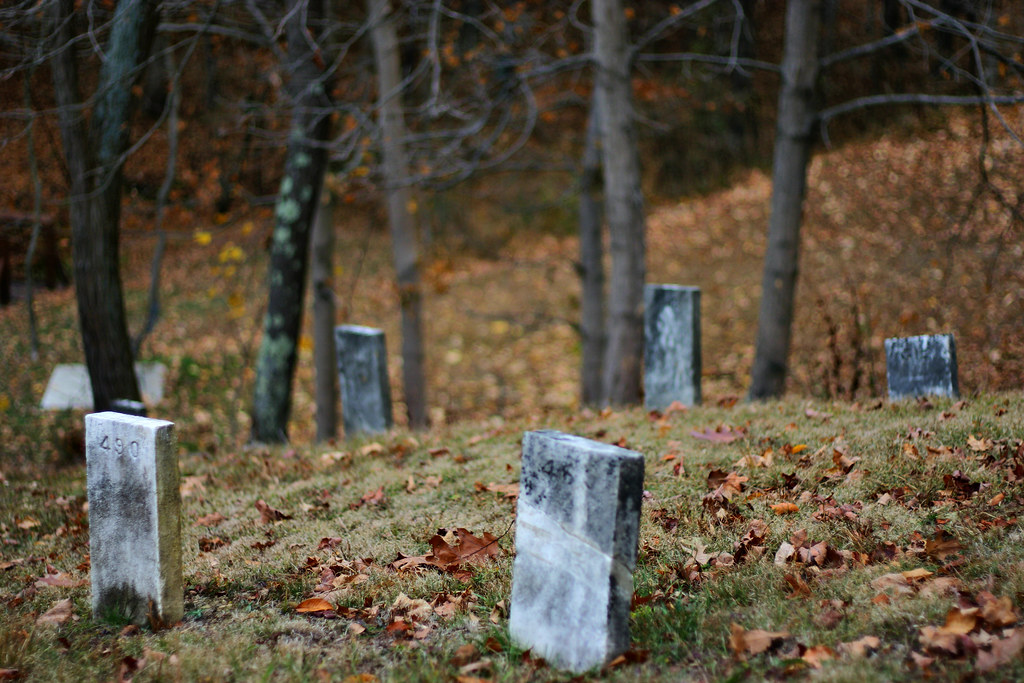
The
"Ridges" cemetery, former Ohio State Asylum for the Insane, (operated
1874-1993), Athens, Ohio.This cemetery at the Ridges in Athens was used
until 1913 as a
final resting place for deceased patients of the Athens Lunatic
Asylum whose families failed to claim their bodies. Grave sites were
mostly numbered, though a few bear names.The "Ridges" cemetery
gravestones were laid out in straight lines, with
the exception of the northeast corner of the cemetery where you will
find a circle of graves. The cemeteries were vulnerable to
vandals for many years. Some believe witches created the circle to hold
seances inside of it, others speculate that it was a prank by
college students: photo by Todd Bender (holysniki), 9 November 2008

Full moon rising above "The Ridges" (former Athens Lunatic Asylum, Athens, Ohio): photo by Mdombroski, 18 January 2079
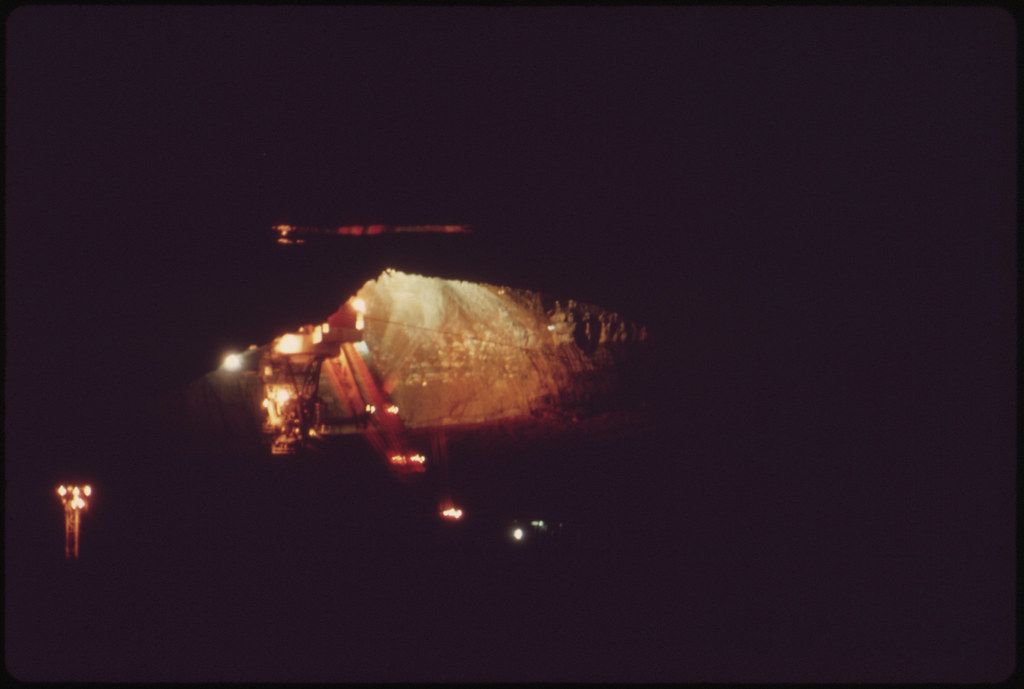

Full moon above "The Ridges" (former Athens Lunatic Asylum, Athens, Ohio): photo by Mdombroski, 18 January 2079
"as can be seen in this general view"; "as a waste of shame lost in its own autism"
ReplyDeleteThis is one of the best, most powerful and haunting movies I have ever seen.
I Am Alive (Bounded by Forest).
The photo of the "small coal shovel" really kills me.
I would like to see this as a call to action as well as a work of art, but I feel frozen in place by the story told in the images and words.
Curtis
Lost in it's own autism . . ,
ReplyDeleteExactly!
Nin and Curtis,
ReplyDeleteSwell to hear your sweet voices in the lonesome dark...
And yes, that small coal shovel!
Some readers of this blog may recall that the skilled photojournalist Erik Calonius, whose Documerica series on Ohio strip mining comprises the backbone of the present post, also made the great New York subway images in Messages from the Underground.
He is a former reporter and foreign correspondent for the Wall Street Journal. He served as Miami Bureau Chief for Newsweek magazine, where he was nominated for the Overseas Press Award. He was also an editor and writer for Fortune Magazine, where he was nominated for the National Magazine Award. He has written two books, and collaborated on more than 20 books, including the bestseller Predictably Irrational, which was named one of the best 100 books of 2008 by the New York Times.
Matt Eich, the very young (b. 1986) and very promising photographer whose images in the second half of this post document the pain and heartbreak that are the socioeconomic burden of the surface-mine rape of his home country, the Athens County, Ohio region, has this to say about the series he calls "Carry Me Ohio":
"Once known for its bounty of coal, salt, clay and timber, Southeastern Ohio was stripped of its resources by the mining corporations that thrived from the 1820s to the 1960s. When they had mined all that they could, the corporations left, leaving the communities with little but their cultural identity, which is a product of poverty.
"For the past three years I have been documenting the people of this region as they attempt to recover from the aftermath of extractive industry. In photographing their daily life, I’ve explored the culture of the area, as well as the crippling poverty that threatens to extinguish it. The foothills of Appalachia have been my home for the past five years. I met my wife here and our daughter was born here. Now, the same lack of opportunity that has plagued the residents of Southeastern Ohio for decades has forced us to move.
"Rampant unemployment, poor housing conditions, drug abuse and sub-standard schools have left many families here in crisis. In 2006, Athens County, one of the poorest counties in the state, had a poverty rate of 27.4 percent and a per capita income of just $14,171. With the economic downturn of the United States these numbers have only gotten worse.
"In this series of images I show the isolated and trapped residents of Southeastern Ohio. From Hercules the German Shepherd, chained to his house in the snow to Timmy, asleep on the couch, trapped in his body and requiring around the clock care from his family. Despite their bleak surroundings there is still a sense of whimsy and beauty in the lives of the region’s occupants. They opened their homes to me and this is my love song to the place [where] I once lived.
"Poverty is more than the lack of monies; it is the deprivation of opportunity and has a lasting emotional resonance for the individuals who live within its grasp. These images strive to remember a forgotten place and a unique time in American history."
If a poem can be wistful, indignant, and resigned, well you wrote it Tom. Combined with this brilliant sequence of photographs I Am Alive (Bounded by Forest) is profoundly disturbing.
ReplyDeleteWhen I study your posts and read the comments, I am energized to say “No!” It ain’t over til it’s over.” Clearly that may be wishful thinking. As long as there is a first amendment (which may also be over) there must be a way to put a stop to the madness of the machine, but it has to be something immediate, brilliant, and effective. Here we are, a group of very bright poets, artists, communicators, etc., going about our lives, saying “Oh well”. “What a shame” (“a waste of shame lost in its own autism” – brilliant – you are a great poet).
The human species has the capacity right now to create abundance. It is technologically possible to do away with fossil and fissile fueled power within a relatively short period. But The Big Money says “More.” No generosity in the “greedhead corporations.” Just Austerity from their governments.
Here is a link to an explanation of how the U.S. competes with Russian gas production (thanks in part to “fracking” transforming the United States into what President Barack Obama has happily hailed as the “Saudi Arabia of natural gas.”) It's a long article and covers some fascinating territory, then concludes:
“If we continue to extract and consume the planet’s vital resources in the same [...] fashion as in the past, we will, sooner rather than later, transform the earth into a barely habitable scene of desolation.” - Michael Klare, Rising Powers, Shrinking Planet
Read entire article here.
Harris Schiff
Everything, from the title/quote, stripped-down elegy, and documentary photos, captures the flickering, defiant spark of life surrounded by overwhelming darkness. The companies, like all rapists, count on that shamed muteness turned within. Thank you for translating their silence.
ReplyDeleteSimilar things are afoot here in California, especially near my old stomping grounds: Fracking in the Golden State
there's no meth in the photos
ReplyDelete- you, the reader, could see (or remember) the movie 'winter's bone' to add this ingredient and complete the portrait
Speaking of forests, the “greedheads” are demanding the right to go fracking in the George Washington National Forest here in Virginia. In Ohio an energy poobah named McClendon is buying up seventy-two thousand fracking acres that sit on top of the Utica shale, for the same purpose: “cutting out the parts they wanted.” Ohio gets slammed again. Even the word “fracking” sounds ugly. Horizontal fracturing sounds painful. The process is both of these—the last desperate measures of a civilization that mainlines hydrocarbons like there’s no tomorrow. Fracking is one of those extractive industries where the energy returned over energy invested quickly goes negative, often in just a few years, which is why they sink so many wells, each one an “investment opportunity” sold and financed by Wall Street. We’ll drink poisoned water and breathe poisoned air as a result, yet for the most part, the “products” of all this deviltry won’t stay in the US; natural gas and oil are priced on the international market and shipped overseas because that’s where the big money is. The same goes for coal. It’s the global economy, hoss. The new feudalism, on a scale I never imagined. It hurts.
ReplyDeleteDON'T EVEN TALK ABOUT IT!
ReplyDelete"CHILDREN GIVEN A LIFELONG BAN ON TALKING ABOUT FRACKING
Two Pennsylvanian children will live their lives under a gag order imposed under a $750,000 settlement"
From The Guardian
Read about it here
Harris
Such abject loss and bewildering tragedy follows/followed base greed and criminality. There are no obvious where-to-from-here answers. The poet, the documentarian lives in sadness.
ReplyDeleteTom,
ReplyDeleteth'expense of spirit in a waste of shame"
"the pure products of America go crazy"
as I was moving through the images at the start of this, I wondered what's going on there now -- then came that abandoned "Silver Spade" and Matt Eich's "Carry Me Ohio" -- Timmy Goins, Troy Goins, "i am alive / Bounded by forest" scrawled at The Ridges. "profoundly disturbing" as Harris notes. . .
8.25
light coming into fog against invisible
ridge, shadowed green of leaf on branch
in foreground, sound of wave in channel
in terms of position, being
instead of what meant
“comprehend” possibility of,
as opposed to, object
silver circle of sun rising above ridge,
fog on horizon to the left of the point
There's such a terrible paucity in that "waste of shame".
ReplyDeleteThe young people in those Matt Eich photos: you can catch the same look in faces around Longbridge (a district of Birmingham). Same riled dogs too, here and there.
It's all painful, it's all tragic, it's all abject, it's all lost, it's all wasteful, it's all a great great shame. In short, it's the American Way, by any other name.
ReplyDeleteI've been burning up my ancient burnt up peepers in a protracted study of the process by which, over a period of not much more than a century, coal companies acquired and exploited the "rights" that "entitled" them to do to the land of this region and its people what we can see here has been done.
Over the same period, for more immediately practical reasons, I've also had to be doing some study of the process by which the insurance or shall we say "healthcare" industries have worked their own dark magic. A solitary individual whose life happens to appear in their sights stands little more chance than any other victim in any target-rich predatory environment.
A few years earlier, again out of necessity, I was forced to learn how businesses (like the school where I'd worked for a long time) are enabled to profit through their own incompetence and mismanagement, at the expense of everyone concerned (excepting of course the entrepreneurs at the top of the pyramid), simply by employing that venerable American success-through-failure tactic, moving the money.
Yesterday the Sunday paper Business section featured a piece on how the new generation of emotionally-neutered tech savants can, much as autistic children, be "helped" to "read" the emotions of others by means of a handy new Google Glass App, which (allegedly) allows the user to detect the "feelings behind" someone's words.
This enterprising technology appears to be based upon the assumption that everybody is lying all the time, which seems accurate enough. The one aspect of the device I would question is the corollary assumption that, beneath the faked sentiments, there lies a rich vein of "true" or "real" ones... and that that vein, like, for instance the coal seam that underlies Appalachia, can be mined inexhaustibly.